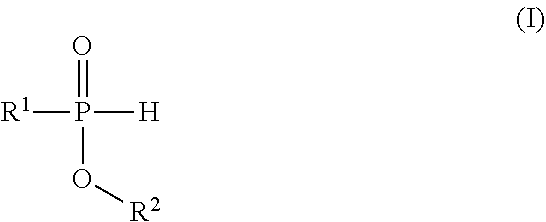Process for producing phosphinates
a technology of phosphinates and phosphinates, which is applied in the direction of biocide, group 5/15 element organic compounds, physical/chemical process catalysts, etc., can solve the problems of insufficient purities and/or yields of alkyl phosphinates, excessive fraction of co-products or by-products, and insufficient purities of alkyl phosphinates
- Summary
- Abstract
- Description
- Claims
- Application Information
AI Technical Summary
Benefits of technology
Problems solved by technology
Method used
Image
Examples
example 1
ethylphosphinate (methanephosphonous acid mono-n-butyl ester)
[0070]38.45 g (0.2684 mol) of diethyl methylphosphonite (purity 95%) and 1.5 g of Amberlyst® 15 (strongly acidic catalyst, synthetic ion exchange resin) in 200 ml of toluene were initially charged in a stirred flask under an argon atmosphere. 4.95 g (0.275 mol) of water and 50 g (0.675 mol) of 1-butanol were added while stirring. Subsequently, the mixture was stirred at 50° C. for 30 min and then heated to reflux (initially ca. 83° C.).
[0071]Low boiling components (ethanol and toluene) were then distilled off via a distillation attachment with a short Vigreux column. After 4 hours another 50 g (0.675 mol) of 1-butanol were added and further low boiling components were distilled off. Finally, at 140° C. at the bottom / 113° C. at the top, a mixture of 37% 1-butanol and 63% toluene (GC analysis) was removed.
[0072]After cooling and removal of the acidic catalyst, 64.3 g remained of a mixture of 55.6% 1-butyl methylphosphinate, ...
example 2
methylphosphinate (methanephosphonous acid mono-n-pentyl ester)
[0077]To 20 g (0.145 mol) of diethyl methylphosphonite (purity 99%) were added 2.62 g (0.145 mol) of water and 64.1 g (0.727 mol) of 1-pentanol and the mixture was reacted in the presence of 0.1 g of 96% sulphuric acid without additional solvent, wherein the mixture was stirred at the start at 50° C. for 30 minutes, and then the internal temperature was increased gradually over 3 hours up to the reflux temperature of 1-pentanol by the end. At the same time, low boiling components were distilled off, at the end only 1-pentanol (GC analysis), which was mostly distilled off.
[0078]According to analysis by GC, the resulting reaction mixture no longer contained reactant.
[0079]After fine distillation under reduced pressure, 21.8 g (0.139 mol) of 1-pentyl methylphosphinate (purity 96%) were obtained from the crude product, corresponding to a yield of 95.8% of theory.
[0080]Analysis: 31P-NMR (CDCl3): 1-pentyl methylphosphinate 34....
example 3
henylphosphinate (phenylphosphonous acid mono-n-butyl ester)
[0081]To 5.0 g (24.7 mmol) of diethyl phenylphosphonite (purity 98%) under argon were added 9.72 g (131.17 mmol) of 1-butanol, 0.445 g (24.7 mmol) of water and 0.3 g of Amberlyst® 15 (strongly acidic catalyst, synthetic ion exchange resin) at 20° C. without additional diluent and the mixture was heated to reflux. Low boiling components were then distilled off via a distillation attachment with a short Vigreux column up to a bottom temperature of 117-120° C. A further 8.1 g (109.31 mmol) of 1-butanol were then added and low boiling components further distilled off at a bottom temperature of about 120° C. The overall reaction lasted in total about 5.5 hours. The profile was monitored by GC analysis. 7.95 g of crude product remained at the end (according to 1H-NMR 58.3%, the residue was 1-butanol). This corresponded to a yield of 94.6% of theory.
[0082]Pure 1-butyl phenylphosphinate could be obtained via a fine distillation und...
PUM
| Property | Measurement | Unit |
|---|---|---|
| pKa | aaaaa | aaaaa |
| temperature | aaaaa | aaaaa |
| stability | aaaaa | aaaaa |
Abstract
Description
Claims
Application Information
 Login to View More
Login to View More - R&D
- Intellectual Property
- Life Sciences
- Materials
- Tech Scout
- Unparalleled Data Quality
- Higher Quality Content
- 60% Fewer Hallucinations
Browse by: Latest US Patents, China's latest patents, Technical Efficacy Thesaurus, Application Domain, Technology Topic, Popular Technical Reports.
© 2025 PatSnap. All rights reserved.Legal|Privacy policy|Modern Slavery Act Transparency Statement|Sitemap|About US| Contact US: help@patsnap.com



